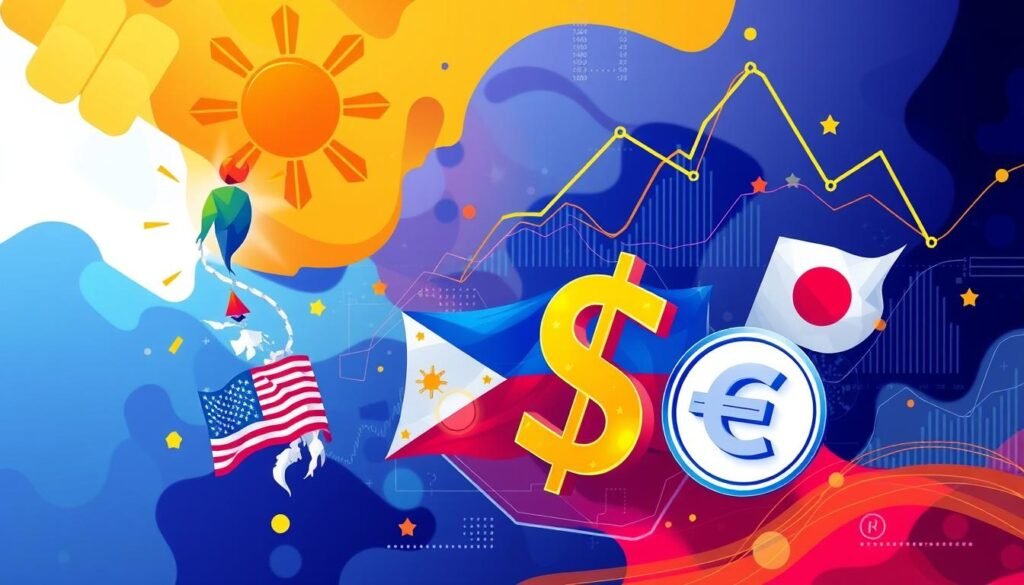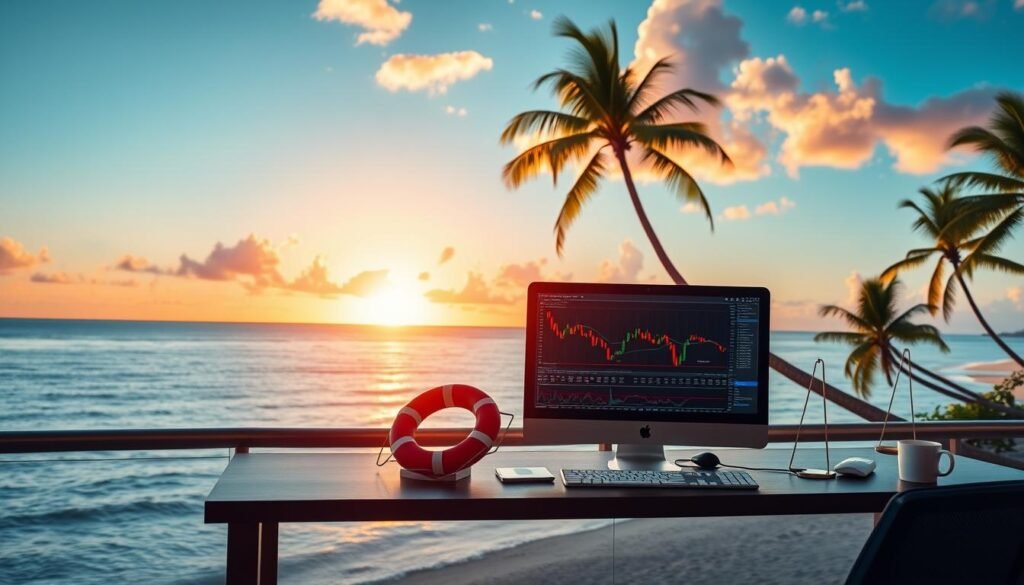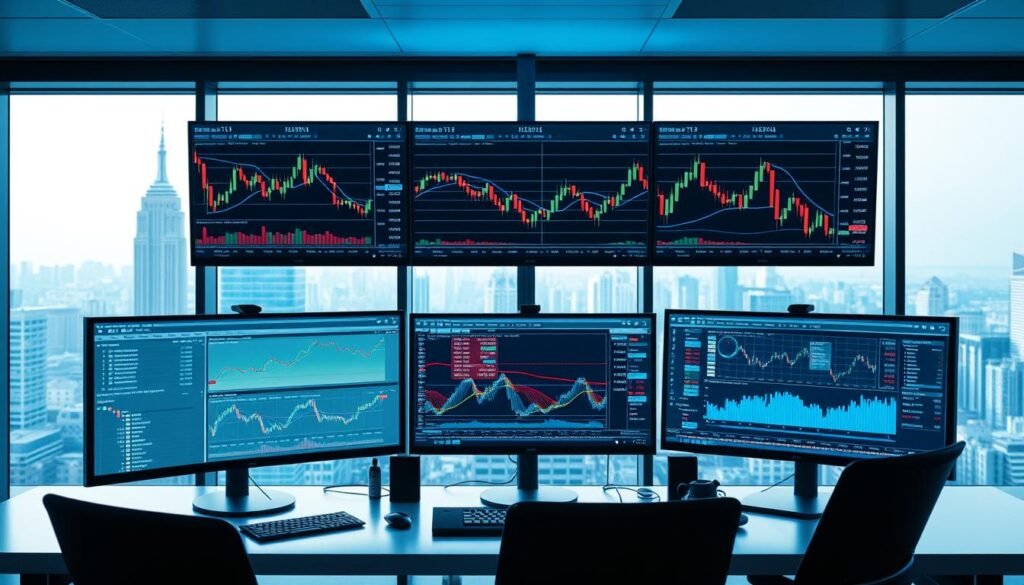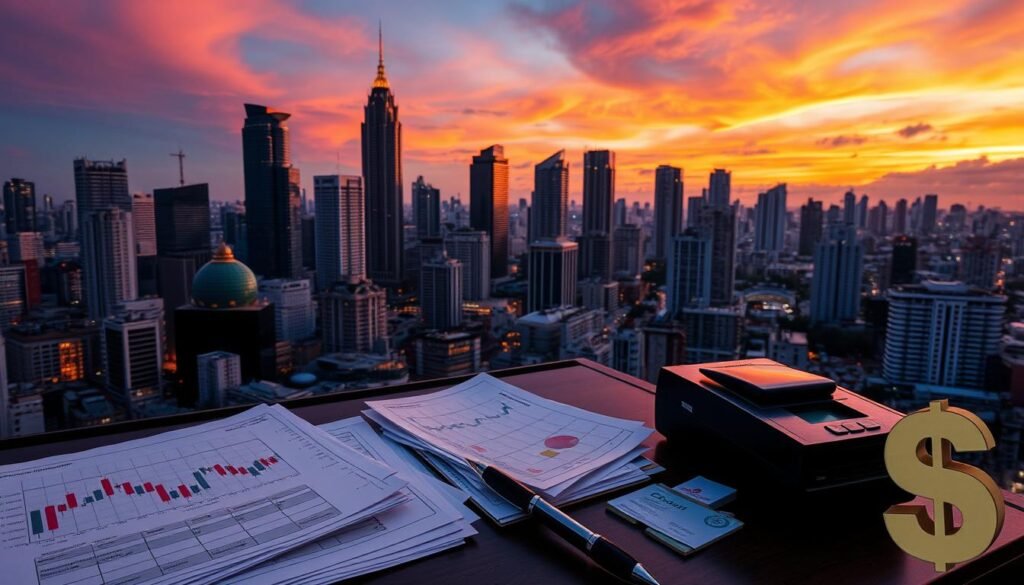Forex Trading in Philippines: Your Ultimate Guide
Forex trading in the Philippines is becoming more popular. It attracts investors looking for new financial chances. This guide will help both new and experienced traders understand foreign exchange trading in the Philippines.
The Philippine forex market is growing fast. It draws traders with its big earning potential. Knowing the basics and the complex parts of forex trading is key. This guide will give you the tools and knowledge to start your forex journey in the Philippines.
Key Takeaways
- Forex trading is gaining traction in the Philippines
- Understanding local regulations is crucial for traders
- Choosing the right broker is essential for success
- Risk management is key in forex trading
- Education and continuous learning are vital for Filipino traders
- The Philippine peso plays a significant role in forex strategies
- Technical and fundamental analysis are important skills to develop
Introduction to Forex Trading in the Philippine Market
The forex market in the Philippines has grown a lot lately. More Filipino traders are getting into currency exchange, looking for ways to make money.
What is Forex Trading?
Forex trading is about buying and selling currencies worldwide. Traders try to make money from changes in exchange rates. Thanks to the internet, Filipinos can trade from home, 24/7.
The Philippine Forex Market at a Glance
The Philippine forex market has grown fast. Local banks and online brokers offer many trading choices. The Bangko Sentral ng Pilipinas makes sure the market is fair and safe for investors.
| Aspect | Details |
|---|---|
| Daily Trading Volume | $200 million (estimated) |
| Major Currency Pairs | USD/PHP, EUR/PHP, JPY/PHP |
| Key Players | BDO, BPI, Metrobank |
Why Forex Trading is Growing in Popularity in the Philippines
Forex trading is becoming more popular in the Philippines for good reasons. It’s easy to get into, offers big returns, and more Filipinos are learning about it. Trading 24/5 fits well with the busy lives of Filipino professionals.
“Forex trading opens up a world of financial possibilities for Filipinos seeking to diversify their investment portfolios.”
As more Filipinos try forex trading, there’s more support for new traders. This growing support is making the forex market in the Philippines even more appealing, creating a cycle of growth.
Legal Framework for Forex Trading in the Philippines
The Philippines has a strong legal setup for forex trading. The Bangko Sentral ng Pilipinas (BSP) is key in regulating this market. They make rules to protect traders and keep the market fair.
BSP makes sure all forex brokers have a license. This means they follow strict financial and operational rules. Before trading, it’s important to check if your broker has this license.
The Securities and Exchange Commission (SEC) also watches over foreign exchange trading in the Philippines. They work to stop fraud and protect investors. SEC rules cover things like risk disclosure and fair marketing.
Filipino traders need to know about Anti-Money Laundering (AML) laws. These laws ask brokers to check client identities and report odd transactions. This keeps the forex market safe and reliable.
“The legal framework for forex trading in the Philippines aims to create a safe and transparent environment for all market participants.”
It’s important to understand these rules for anyone into forex trading in the Philippines. It helps avoid scams and makes sure traders follow the law. The BSP and SEC websites have all the latest information on regulations.
Getting Started: Requirements for Forex Trading in the Philippines
Starting your journey in online forex trading philippines requires meeting specific criteria. This guide outlines the key requirements for aspiring traders in the country.
Age and Residency Requirements
To engage in forex trading, you must be at least 18 years old and a legal resident of the Philippines. Some forex broker philippines may require traders to be 21 or older, so check their specific terms.
Documentation Needed
Prepare these essential documents to open a forex trading account:
- Valid government-issued ID (e.g., passport, driver’s license)
- Proof of address (recent utility bill or bank statement)
- Tax Identification Number (TIN)
- Bank account details for fund transfers
Initial Capital Considerations
The minimum capital required varies among brokers. Here’s a comparison of typical initial deposit requirements:
| Account Type | Minimum Deposit | Suitable For |
|---|---|---|
| Micro Account | $50 – $200 | Beginners |
| Standard Account | $500 – $1000 | Intermediate Traders |
| VIP Account | $5000+ | Experienced Traders |
Remember, successful forex trading requires more than meeting basic requirements. Educate yourself about market dynamics and develop a solid trading strategy before risking real capital.
By fulfilling these requirements, you’ll be well-positioned to start your forex trading journey in the Philippines. Choose a reputable forex broker philippines that aligns with your trading goals and risk tolerance.
Choosing the Right Forex Broker in the Philippines
Finding a good forex broker philippines is key for success in online forex trading philippines. The right broker can greatly improve your trading experience and earnings.
- Regulation: Make sure the broker is licensed by well-known financial bodies.
- Trading platforms: Choose platforms that are easy to use and have advanced features.
- Customer support: Go for brokers that offer 24/7 help in many languages.
- Fees and spreads: Compare costs to increase your trading profits.
- Educational resources: Pick brokers that provide a lot of learning materials.
To guide you, here’s a look at the top forex brokers for Filipino traders:
| Broker | Regulation | Min. Deposit | Spreads | Customer Support |
|---|---|---|---|---|
| XM | CySEC, ASIC | $5 | From 0.6 pips | 24/7 Live Chat, Email, Phone |
| eToro | CySEC, FCA, ASIC | $200 | From 1 pip | 24/5 Live Chat, Email |
| IG | FCA, ASIC, MAS | $250 | From 0.6 pips | 24/5 Live Chat, Email, Phone |
The best forex broker philippines for you depends on your trading needs and preferences. Spend time researching and comparing before choosing a broker for your online forex trading philippines journey.
Top Forex Trading Platforms Available to Filipino Traders
Filipino traders have many advanced platforms for forex trading. These tools meet different trading needs, making online trading better for everyone.
MetaTrader 4 and 5
MetaTrader platforms are favorites for trading in the Philippines. MT4 is easy to use and has great charting tools. MT5 adds more features, like more timeframes and analysis tools.
Both platforms allow automated trading and have mobile apps. This makes trading easy anywhere, anytime.
cTrader
cTrader is becoming more popular in the Philippines. It has a modern look and supports advanced orders. It’s perfect for scalpers and day traders because of its detailed market data.
WebTrader Options
WebTrader platforms are great for trading in the Philippines. They don’t need software downloads. They have simple interfaces and live market data, perfect for those who want easy access.
| Platform | Key Features | Best For |
|---|---|---|
| MetaTrader 4 | Expert Advisors, Custom Indicators | Beginners, Algorithmic Traders |
| MetaTrader 5 | Multi-asset Trading, Advanced Charting | Experienced Traders, Multi-market Traders |
| cTrader | Depth of Market, Level II Pricing | Scalpers, Professional Traders |
| WebTrader | Browser-based, No Downloads | Casual Traders, Beginners |
Understanding Currency Pairs Popular Among Filipino Traders
The forex market philippines offers a wide array of currency pairs for traders to explore. Filipino traders often focus on specific pairs that align with their trading strategies and economic interests.

In currency trading philippines, the USD/PHP pair stands out as a favorite. This pairing directly impacts the local economy and provides opportunities for traders to capitalize on peso fluctuations. Major pairs like EUR/USD and GBP/USD also attract attention due to their high liquidity and global economic significance.
Minor pairs involving the Japanese Yen, such as USD/JPY and EUR/JPY, gain traction among Filipino traders. Japan’s strong economic ties with the Philippines make these pairs particularly relevant. Exotic pairs featuring emerging market currencies like USD/SGD or AUD/NZD appeal to risk-tolerant traders seeking higher volatility.
“Understanding popular currency pairs is crucial for success in the Philippine forex market. It allows traders to make informed decisions based on economic factors and market trends.”
Factors influencing pair popularity include trade relations, remittance flows, and global economic events. Filipino traders often monitor these elements to gauge potential market movements and adjust their strategies accordingly.
- USD/PHP: Direct impact on local economy
- EUR/USD, GBP/USD: High liquidity, global significance
- USD/JPY, EUR/JPY: Strong economic ties with Japan
- Exotic pairs: Higher risk, potential for greater returns
By focusing on these popular pairs, Filipino traders can develop specialized expertise. This can potentially improve their trading outcomes in the dynamic forex market philippines.
Forex Trading Strategies Suited for the Philippine Market
Forex trading in the Philippines offers many strategies for local traders. They can pick from various methods based on their goals and how much risk they’re willing to take. Let’s look at some top forex strategies used by Filipino traders in the currency markets.
Day Trading Strategies
Day trading is a favorite among Filipino forex traders who aim for quick profits. This method involves opening and closing trades in one day. Scalping and news trading are common tactics in the Philippines.
Traders look for short-term price changes and economic news to make fast decisions.
Swing Trading Approaches
Swing trading is for those who are patient in the Philippines’ forex market. It aims to catch bigger price swings over days or weeks. Filipino swing traders use technical analysis to spot trends and potential reversals.
They might hold positions for several days, giving them more flexibility in their trading schedule.
Long-term Position Trading
Position trading is best for Filipino traders with a long-term view. This strategy involves holding positions for weeks, months, or even years. Traders focus on fundamental analysis, studying economic trends and global events that affect currency values.
This approach needs less daily checking but requires a deep understanding of global economics.
| Strategy | Time Frame | Risk Level | Skill Required |
|---|---|---|---|
| Day Trading | Minutes to Hours | High | Advanced |
| Swing Trading | Days to Weeks | Medium | Intermediate |
| Position Trading | Weeks to Years | Low | Beginner to Intermediate |
Choosing the right strategy depends on your personal preferences, time commitment, and risk tolerance. Many Filipino traders mix elements from different strategies to create a strategy that fits their needs and the Philippine market’s unique characteristics.
Risk Management Techniques for Philippine Forex Traders
Effective risk management is key to success in forex trading in the Philippines. Filipino traders need to learn important techniques. These help protect their investments and increase profits in the changing currency markets.

Setting stop-loss orders is a basic practice in currency trading in the Philippines. This method closes a trade when it hits a set loss level. It stops further damage to your account. For instance, setting a stop-loss at 1% of your account balance per trade can help keep your capital safe over time.
Managing leverage is also vital for risk control. High leverage can boost profits but also raises potential losses. Filipino traders should start with lower leverage and increase it as they get more experience and confidence in their strategies.
Diversifying investments is crucial to reduce risk in forex trading. Trading in different currency pairs can balance losses in one market with gains in another. This is especially important for traders in the Philippines, where economic factors can greatly affect the local currency.
| Risk Management Technique | Description | Benefit |
|---|---|---|
| Stop-Loss Orders | Automatic trade closure at predetermined loss level | Limits potential losses |
| Leverage Management | Controlled use of borrowed funds | Balances risk and reward |
| Portfolio Diversification | Trading multiple currency pairs | Spreads risk across markets |
By using these risk management techniques, Filipino forex traders can build a stable and profitable trading career in the long run.
The Role of Fundamental Analysis in Philippine Forex Trading
Fundamental analysis is key in forex trading in the Philippines. Traders must know about important economic signs and global events. This knowledge helps them make smart trading choices and guess currency movements.
Key Economic Indicators to Watch
Filipino forex traders should watch these key economic signs:
- Gross Domestic Product (GDP)
- Inflation rates
- Interest rates set by Bangko Sentral ng Pilipinas
- Employment figures
- Trade balance data
These signs show how the Philippine economy is doing. They can also change the peso’s value in the forex market.
Impact of Global Events on the Philippine Peso
Global events greatly affect the Philippine peso’s value. Things like political tensions, natural disasters, and changes in big economies can make the forex market in the Philippines change. For example, changes in US economic policies often affect the USD/PHP pair, a favorite among Filipino traders.
“Understanding global economic trends is essential for successful forex trading in the Philippines. It allows traders to anticipate market movements and make strategic decisions.”
By getting good at fundamental analysis, Filipino traders can stand out in the forex market. This skill, along with technical analysis, is the base for making money in forex trading.
Technical Analysis Tools for Philippine Forex Traders
Forex analysis in the Philippines depends a lot on technical tools. These tools help traders find trends, decide when to buy or sell, and manage risks. Let’s look at some key tools used by Filipino forex traders.

Chart patterns are very important in forex strategies in the Philippines. Traders look for patterns like head and shoulders and triangles to guess price movements. Trend lines are also key, showing the market’s direction.
Moving averages smooth out price data to show trends. Filipino traders use different moving averages to find buy and sell signals. The relative strength index (RSI) is also popular, showing when prices are too high or too low.
Fibonacci retracements help traders find support and resistance levels. These levels are based on Fibonacci ratios. They help set profit targets and stop-loss orders.
“Technical analysis is like a roadmap for traders. It helps us navigate the complex forex market and make data-driven decisions,” says Maria Santos, a seasoned forex trader from Manila.
Bollinger Bands are also valuable in forex analysis in the Philippines. These bands have a moving average and upper and lower bands that change with market volatility. Traders use them to spot breakouts and measure volatility.
By learning these technical tools, Filipino forex traders can improve their strategies. This can increase their success in the fast-paced forex market.
Forex Trading Education and Resources in the Philippines
The forex education scene in the Philippines is growing fast. Traders can find many tools to improve their skills. Let’s look at the best resources available.
Online Courses and Webinars
Digital platforms offer flexible learning for Filipino forex traders. Many brokers have free webinars and video tutorials. These cover everything from basics to advanced strategies, for all skill levels.
Local Forex Trading Seminars
In-person seminars are a hit with Filipino traders. These events have expert speakers and hands-on training. Attendees can meet other traders and learn from their experiences.
Books and Ebooks on Forex Trading
Reading materials are key in forex education. Many Filipino authors have written books for the local market. These often include case studies that are relevant to trading in the Philippines.
| Resource Type | Advantages | Popular Options |
|---|---|---|
| Online Courses | Flexible, self-paced learning | Udemy, Coursera |
| Webinars | Live interaction with experts | BabyPips, FX Academy |
| Local Seminars | Networking opportunities | PSE Academy, FXTP |
| Books/Ebooks | In-depth knowledge | “Forex for Beginners” by Anna Coulling |
Using these resources together makes a strong forex education plan. Traders can customize their learning to fit their needs and schedule. With hard work and the right tools, success in forex trading in the Philippines is possible.
Tax Implications of Forex Trading in the Philippines
Forex trading in the Philippines comes with tax responsibilities. Traders must understand their obligations to stay compliant with local laws. The Bureau of Internal Revenue (BIR) oversees taxation for foreign exchange trading Philippines activities.
Income from forex trading is generally subject to income tax. Traders need to report their earnings and pay taxes accordingly. The tax rate depends on the trader’s income bracket and can range from 0% to 35%.

Capital gains from forex trading may also be taxable. Traders should keep detailed records of their transactions to accurately calculate gains and losses. It’s crucial to maintain proper documentation for tax reporting purposes.
| Tax Type | Rate | Reporting Frequency |
|---|---|---|
| Income Tax | 0% – 35% | Annually |
| Capital Gains Tax | 6% | Per transaction |
| Value Added Tax | 12% | Monthly or Quarterly |
Traders engaged in forex trading in the Philippines should consider consulting with a tax professional. They can provide guidance on filing requirements and potential deductions. Staying informed about tax laws helps traders avoid penalties and ensure compliance.
Common Mistakes to Avoid in Philippine Forex Trading
Forex trading in the Philippines is on the rise. But, many new traders fall into common traps. Let’s look at these pitfalls and how to avoid them for successful trading.
Overtrading is a big mistake. New traders often make too many trades, hoping for quick wins. This increases costs and can lead to losses. Instead, focus on making fewer, better trades.
Poor risk management can hurt your trading account. Many Filipino traders don’t set stop-loss orders or risk too much. Try to risk no more than 1-2% of your account on any trade.
Emotional decision-making is another trap. Fear and greed can lead to impulsive trades. Create a solid trading plan and stick to it, even when the market changes.
| Common Mistake | Impact | Solution |
|---|---|---|
| Overtrading | High costs, increased losses | Focus on quality trades |
| Poor risk management | Account depletion | Use stop-loss, limit risk per trade |
| Emotional trading | Impulsive decisions | Follow a trading plan |
Lack of education is a big problem. Many jump into forex trading without learning enough. Spend time learning about currency markets, technical analysis, and economic factors.
“Education is the passport to the future, for tomorrow belongs to those who prepare for it today.” – Malcolm X
By avoiding these common mistakes, you’ll be on the path to success in forex trading in the Philippines. Remember, patience and continuous learning are essential for mastering currency trading.
Success Stories: Filipino Forex Traders Who Made It Big
The world of forex trading in Philippines has seen many success stories. These stories show that with hard work and smart strategies, Filipino traders can do great things. They prove that success in the foreign exchange market is possible.
Mario Sanchez, from Manila, is a great example. He started with little knowledge, learning from online resources. After years of effort, Mario now runs a successful trading firm. He helps others in the exciting world of foreign exchange trading Philippines.
Lisa Cruz from Cebu is another success story. She turned her love for economics into a successful forex career. Lisa combines deep market analysis with careful risk management. Her story shows that success in forex trading comes from skill and hard work, not just luck.
These Filipino forex traders are true inspirations. They show that with the right mindset and strategies, anyone can succeed in the challenging yet rewarding field of forex trading in Philippines.
FAQ
What is Forex trading?
Forex trading is buying and selling currencies to make money from rate changes. It’s about trading one currency for another, hoping to guess the future value of a pair.
Is Forex trading legal in the Philippines?
Yes, Forex trading is legal in the Philippines. It’s overseen by the Bangko Sentral ng Pilipinas (BSP) and the Securities and Exchange Commission (SEC). Traders must follow the laws and rules for Forex.
What are the age and residency requirements for Forex trading in the Philippines?
Most Forex brokers in the Philippines want traders to be at least 18. Filipino citizens and residents can trade, but some brokers also accept non-residents under certain conditions.
How do I choose the right Forex broker in the Philippines?
Look for a Forex broker in the Philippines that is regulated and offers good customer support. Check their fees, leverage options, and reputation. Make sure they are authorized to operate in the country.
What are the popular Forex trading platforms available to Filipino traders?
Filipino traders often use MetaTrader 4 and 5, cTrader, and WebTrader options. These platforms are easy to use and have advanced tools.
What currency pairs are commonly traded by Filipino Forex traders?
Filipino traders often trade pairs like EUR/USD, USD/JPY, and GBP/USD. They also trade pairs with the Philippine Peso, such as USD/PHP.
What Forex trading strategies are suitable for the Philippine market?
Filipino traders can use day trading, swing trading, and long-term position trading. The best strategy depends on the trader’s style, risk tolerance, and market conditions. It’s important to have a clear strategy and risk plan.
How can I manage risk when trading Forex in the Philippines?
Managing risk is key in Forex trading. Use stop-loss orders, manage leverage wisely, and diversify portfolios. These steps help control risk and protect capital. Good risk management is crucial for success.
What educational resources are available for Forex trading in the Philippines?
Traders in the Philippines can find many educational resources. There are online courses and webinars, local Forex trading seminars, and books and ebooks on Forex. These help improve knowledge and skills in analysis, strategy, and risk management.
